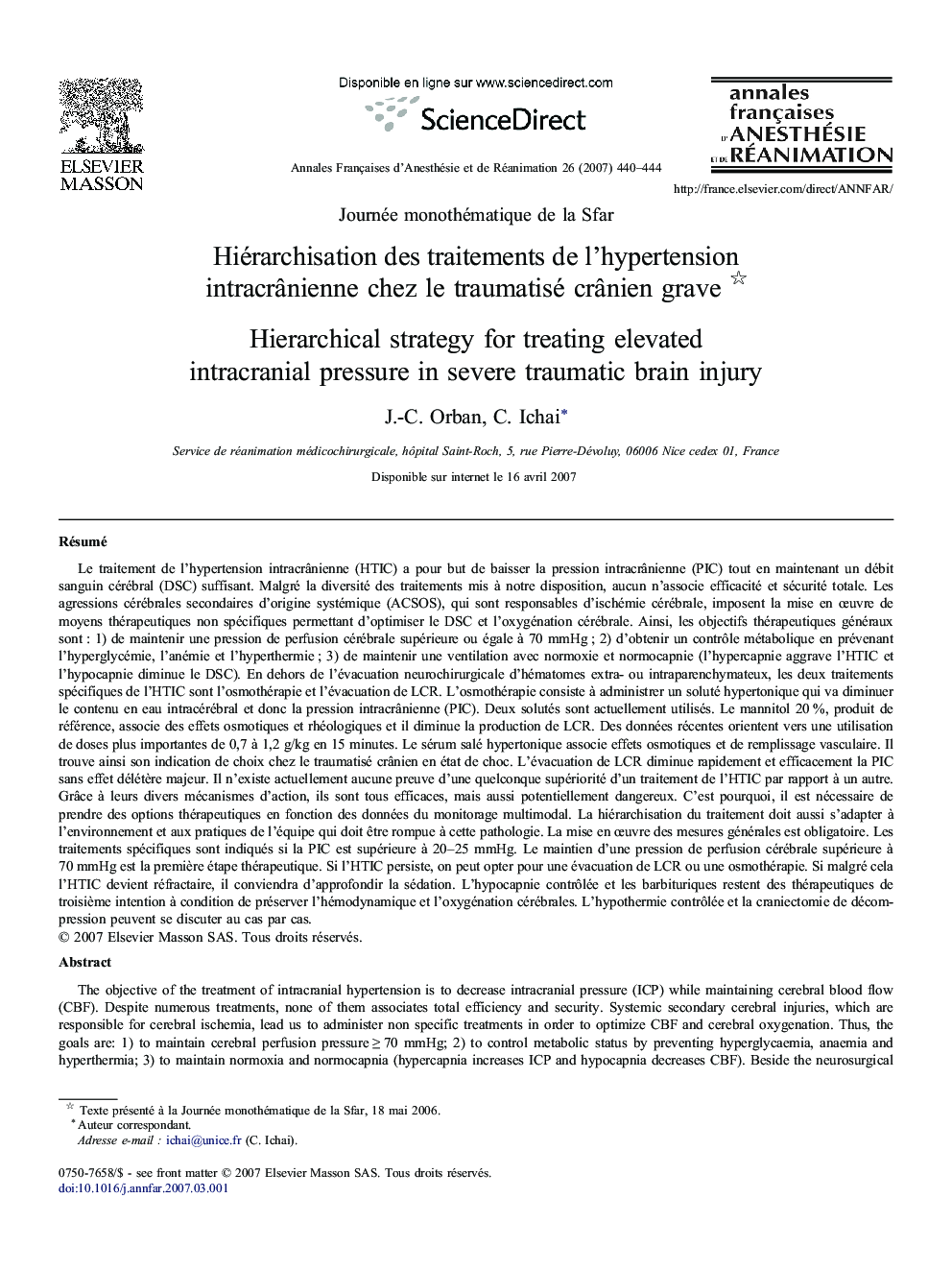| کد مقاله | کد نشریه | سال انتشار | مقاله انگلیسی | نسخه تمام متن |
|---|---|---|---|---|
| 2747749 | 1148926 | 2007 | 5 صفحه PDF | دانلود رایگان |

RésuméLe traitement de l'hypertension intracrânienne (HTIC) a pour but de baisser la pression intracrânienne (PIC) tout en maintenant un débit sanguin cérébral (DSC) suffisant. Malgré la diversité des traitements mis à notre disposition, aucun n'associe efficacité et sécurité totale. Les agressions cérébrales secondaires d'origine systémique (ACSOS), qui sont responsables d'ischémie cérébrale, imposent la mise en œuvre de moyens thérapeutiques non spécifiques permettant d'optimiser le DSC et l'oxygénation cérébrale. Ainsi, les objectifs thérapeutiques généraux sont : 1) de maintenir une pression de perfusion cérébrale supérieure ou égale à 70 mmHg ; 2) d'obtenir un contrôle métabolique en prévenant l'hyperglycémie, l'anémie et l'hyperthermie ; 3) de maintenir une ventilation avec normoxie et normocapnie (l'hypercapnie aggrave l'HTIC et l'hypocapnie diminue le DSC). En dehors de l'évacuation neurochirurgicale d'hématomes extra- ou intraparenchymateux, les deux traitements spécifiques de l'HTIC sont l'osmothérapie et l'évacuation de LCR. L'osmothérapie consiste à administrer un soluté hypertonique qui va diminuer le contenu en eau intracérébral et donc la pression intracrânienne (PIC). Deux solutés sont actuellement utilisés. Le mannitol 20 %, produit de référence, associe des effets osmotiques et rhéologiques et il diminue la production de LCR. Des données récentes orientent vers une utilisation de doses plus importantes de 0,7 à 1,2 g/kg en 15 minutes. Le sérum salé hypertonique associe effets osmotiques et de remplissage vasculaire. Il trouve ainsi son indication de choix chez le traumatisé crânien en état de choc. L'évacuation de LCR diminue rapidement et efficacement la PIC sans effet délétère majeur. Il n'existe actuellement aucune preuve d'une quelconque supériorité d'un traitement de l'HTIC par rapport à un autre. Grâce à leurs divers mécanismes d'action, ils sont tous efficaces, mais aussi potentiellement dangereux. C'est pourquoi, il est nécessaire de prendre des options thérapeutiques en fonction des données du monitorage multimodal. La hiérarchisation du traitement doit aussi s'adapter à l'environnement et aux pratiques de l'équipe qui doit être rompue à cette pathologie. La mise en œuvre des mesures générales est obligatoire. Les traitements spécifiques sont indiqués si la PIC est supérieure à 20–25 mmHg. Le maintien d'une pression de perfusion cérébrale supérieure à 70 mmHg est la première étape thérapeutique. Si l'HTIC persiste, on peut opter pour une évacuation de LCR ou une osmothérapie. Si malgré cela l'HTIC devient réfractaire, il conviendra d'approfondir la sédation. L'hypocapnie contrôlée et les barbituriques restent des thérapeutiques de troisième intention à condition de préserver l'hémodynamique et l'oxygénation cérébrales. L'hypothermie contrôlée et la craniectomie de décompression peuvent se discuter au cas par cas.
The objective of the treatment of intracranial hypertension is to decrease intracranial pressure (ICP) while maintaining cerebral blood flow (CBF). Despite numerous treatments, none of them associates total efficiency and security. Systemic secondary cerebral injuries, which are responsible for cerebral ischemia, lead us to administer non specific treatments in order to optimize CBF and cerebral oxygenation. Thus, the goals are: 1) to maintain cerebral perfusion pressure ≥ 70 mmHg; 2) to control metabolic status by preventing hyperglycaemia, anaemia and hyperthermia; 3) to maintain normoxia and normocapnia (hypercapnia increases ICP and hypocapnia decreases CBF). Beside the neurosurgical evacuation of extra- and intraparenchymatous haematomas, osmotherapy and cerebrospinal fluid (CSF) evacuation are the two specific treatments of intracranial hypertension. Osmotherapy consists in an administration of a hypertonic solution which induces a decrease in cerebral water and finally in ICP. Mannitol (20%), which is the reference, associates osmotic and rheologic effects, and decreases CSF production too. Recent data conduct us to administer larger doses, between 0.7 and 1 g/kg in 15 minutes. Hypertonic saline solution associates osmotic effects and plasma volume loading. Thus, this solution is particularly appropriate in severe head injury with arterial hypotension. CBF evacuation decreases rapidly ICP without any major side-effect. Until now, there is no proof of a superior efficiency of a treatment for intracranial hypertension compared to another. Considering their mechanism of action, all of them are efficient but potentially dangerous too. Indeed, the choice between treatments depends on data which are issued from the multimodal monitoring. General non specific treatments are always necessary. Specific treatments are indicated if ICP is above 20-25 mmHg. Maintaining cerebral perfusion pressure represents the first therapeutic goal. If intracranial hypertension persists, evacuation of CBF or osmotherapy may be advocated. In case of refractory intracranial hypertension, it may be useful to deepen neurosedation. Controlled hypocapnia and barbiturates remain a third line therapy providing to monitor and maintain an appropriate CBF and cerebral oxygenation. Controlled hypothermia and decompressive craniectomy must be individually discussed.
Journal: Annales Françaises d'Anesthésie et de Réanimation - Volume 26, Issue 5, May 2007, Pages 440–444